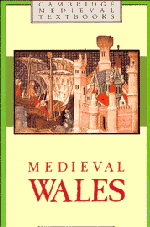Book contents
- Frontmatter
- Contents
- List of figures
- List of maps
- Preface
- 1 Wales in the dark ages
- 2 The Normans in Wales
- 3 The marcher lordships
- 4 The church in Wales
- 5 Crisis of identity: towards a principality of Wales
- 6 The Edwardian conquest
- 7 Under the heel: Wales in the fourteenth century
- 8 Resurgence and decline: the fifteenth century
- 9 A new dawn? The coming of the Tudors
- Select bibliography
- Index
- Cambridge Medieval Textbooks
9 - A new dawn? The coming of the Tudors
Published online by Cambridge University Press: 05 June 2012
- Frontmatter
- Contents
- List of figures
- List of maps
- Preface
- 1 Wales in the dark ages
- 2 The Normans in Wales
- 3 The marcher lordships
- 4 The church in Wales
- 5 Crisis of identity: towards a principality of Wales
- 6 The Edwardian conquest
- 7 Under the heel: Wales in the fourteenth century
- 8 Resurgence and decline: the fifteenth century
- 9 A new dawn? The coming of the Tudors
- Select bibliography
- Index
- Cambridge Medieval Textbooks
Summary
The Tudors, distant descendants of Ednyfed Fychan, the administrator who had served Llywelyn ap Gruffydd and, after his death, Edward I, were substantial landholders in Anglesey and strong supporters of Richard II, under whom they acquired a series of local offices which added to their wealth and influence. Their hostility to Henry IV and the Lancastrians led them into open rebellion and their activities complemented the early phases of the revolt of Owain Glyn Dŵr. They were penalised heavily. Rhys ap Tudur was captured and executed in 1412; his brother, Gwilym, was pardoned in the following year; some of the forfeited Tudor estates passed into the hands of their niece, Morfudd, and her husband, Gwilym ap Gruffydd. Maredudd ap Tudur, who may have been the youngest of his generation, kept his share of the family's lands, and his son, Owen – the anglicised form has to be used in this context – found employment in the royal service as an officer in the household of Henry V's queen, Catherine. After Henry V's death, leading politicians were anxious that his widow should not remarry, though Cardinal Beaufort saw her as a valuable alliance for one of his young kinsmen. To prevent that, a statute was passed in 1427–8 requiring the king's permission for any future marriage and providing heavy penalties for anyone who ignored the statute. The queen and her Welsh esquire formed a strong attachment and perhaps as early as 1431–2 they were married in defiance of the statute.
- Type
- Chapter
- Information
- Medieval Wales , pp. 186 - 191Publisher: Cambridge University PressPrint publication year: 1990



